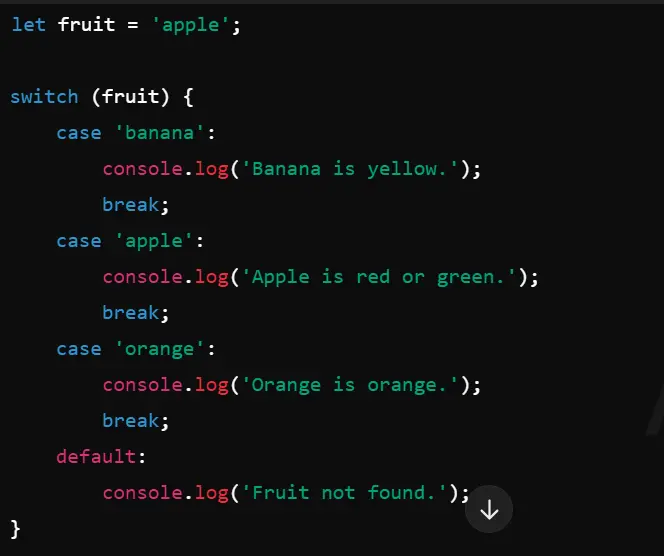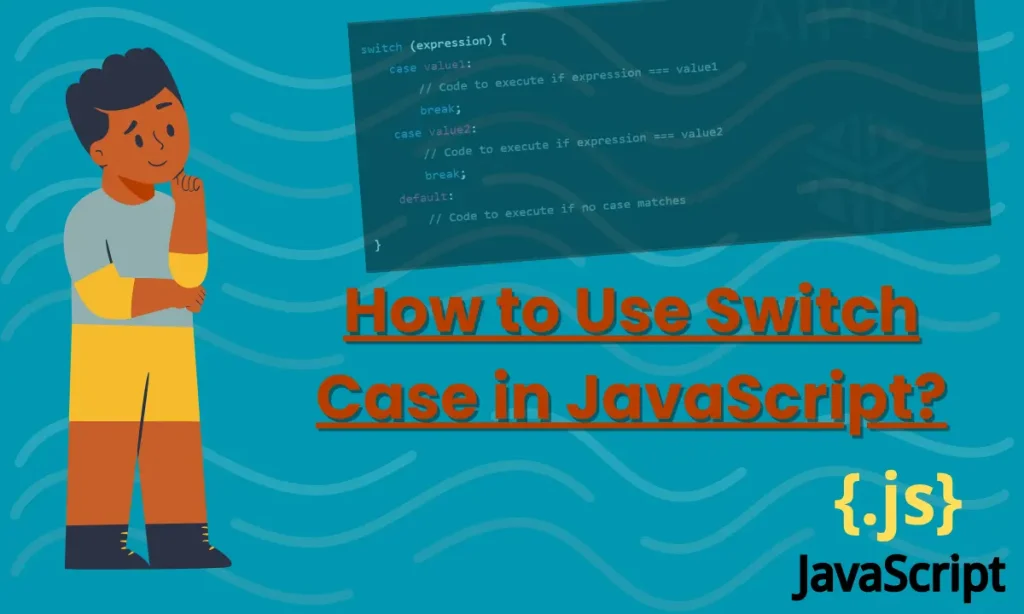How to Use Switch Case in JavaScript -In JavaScript, the switch statement is a control structure that allows for more readable decision-making in code, especially when multiple possible outcomes are based on the value of a variable or expression. Instead of writing several if...else if conditions, a switch case simplifies the process, making your code cleaner and more maintainable.
Table of Contents
Basic Syntax of Switch Case
The switch statement checks an expression and executes code based on matching case values. Here’s the basic syntax:

In this syntax:
- Expression: The value or condition you are evaluating.
- Case: Each
casechecks if the expression matches the value specified. If it does, the block of code is executed. - Break: The
breakstatement stops further execution inside the switch case. Without it, JavaScript will execute all following cases (fall-through behavior). - Default: The
defaultcase is executed when none of thecasevalues match the expression.
Example: Switch Case in Action
Let’s look at a simple example that checks the type of fruit and logs a message:

Explanation:
- The
fruitvariable holds the value'apple‘. - The
switchstatement evaluates the variable and compares it with eachcasevalue. - Since
'apple'matches the secondcase, it logsApple as red or green.to the console. - If none of the cases matched, the
defaultcase would have been executed.
Switch Case with Multiple Conditions
One of the lesser-known but powerful features of the switch statement is that multiple case values can share the same outcome. Here’s how you can handle multiple conditions that result in the same output:

Explanation:
- Here,
case 1throughcase 5share the same block of code, printingIt’s a weekday. - if the
dayis between 1 and 5. - Similarly,
case 6andcase 7share the same block, printingIt’s the weekend!
Handling Fall-Through in Switch Statements
In JavaScript, the switch statement will “fall through” if you do not include a break statement. This means that if one case matches, the code for all subsequent cases will execute until a break is encountered or the switch ends. While this can be useful, it can also lead to unexpected behavior if not handled carefully.
Here’s an example illustrating fall-through behavior: How to Use Switch Case in JavaScript

Explanation: How to Use Switch Case in JavaScript
The value of number is 2, so case 2 matches.
Since there is no break after case 2, the code continues executing the block for case 3, resulting in the output:
TwoThree
To avoid this, always include a break unless you explicitly want fall-through behavior.
| What is an IIFE Function in JavaScript?(learn-these-2-new-ways) |
| What Are Semantic Tags in HTML? (With 2 examples) |
Switch Case vs If…Else
Both switch statements and if...else structures can be used for decision-making, but there are some key differences:
| Switch Case | If…Else |
|---|---|
| Easier to read when there are many conditions | Better for more complex or non-equal comparisons |
Only checks for equality (===) | Can evaluate any condition (logical or comparison) |
Stops execution with break statements | Stops when the condition is met or reaches else |
| Often more concise for simple comparisons | More flexible and handles a wider range of conditions |
1. What is a JavaScript switch?
A JavaScript switch case is a control structure that checks the value of a variable or expression and executes code based on the matching case. It offers a cleaner alternative to multiple if...else statements.
2. What is the role of the break statement in switch cases?
The break statement prevents fall-through behavior, ensuring that once a matching case is executed, the program exits the switch statement without executing further cases.
3. When should I use a switch instead of if…else?
Use a switch when you are comparing a variable to multiple exact values. Use if...else when you need more complex logic, such as relational or logical comparisons.
Conclusion: How to Use Switch Case in JavaScript
The switch case in JavaScript is an excellent tool for handling multiple possible outcomes based on the value of a single expression or variable. It’s particularly useful when checking a variable against a set of values, making your code more readable and easier to maintain.
By using the switch case correctly, you can make your programs more efficient and organized, especially when dealing with multiple conditions. Remember to always include break statements unless you specifically need fall-through behavior, and consider using a switch when you find yourself writing multiple if...else statements based on the same variable.








